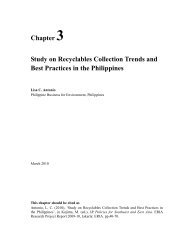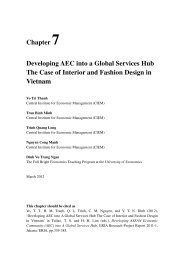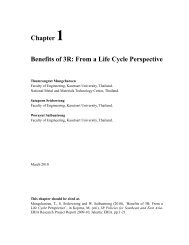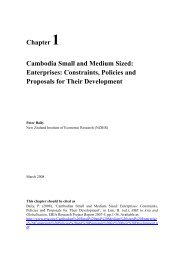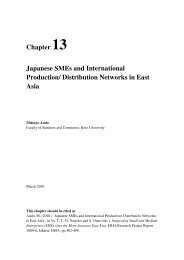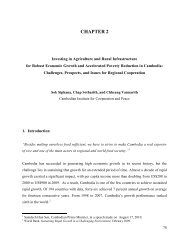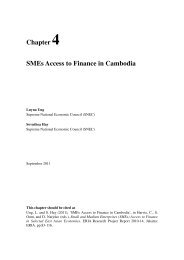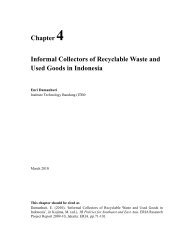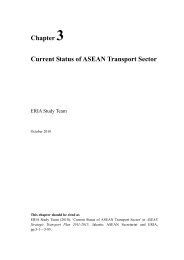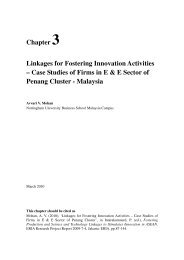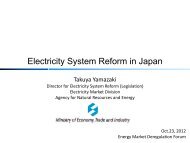Bank Efficiency, Regulation and Response to Crisis of ... - ERIA
Bank Efficiency, Regulation and Response to Crisis of ... - ERIA
Bank Efficiency, Regulation and Response to Crisis of ... - ERIA
You also want an ePaper? Increase the reach of your titles
YUMPU automatically turns print PDFs into web optimized ePapers that Google loves.
markets. Malaysian policies are argued by some <strong>to</strong> have led in the short run <strong>to</strong> a fastereconomic recovery, smaller decline in unemployment <strong>and</strong> wages, <strong>and</strong> a more rapidturnaround <strong>of</strong> the s<strong>to</strong>ck market (Kaplan <strong>and</strong> Rodrik, 2001). However, there is no clearevidence <strong>of</strong> the impact <strong>of</strong> capital controls in the long run on bank efficiency. Anunderst<strong>and</strong>ing <strong>of</strong> the impact <strong>of</strong> foreign participation on the productive performance <strong>of</strong>banks in the long term is valuable. A recent study by Kose et al. (2009) also shows thatfinancial openness has a robust positive impact on TFP growth in the domestic economy.A study by Xu (2010) provides strong empirical evidence that foreign entry led <strong>to</strong> amore competitive <strong>and</strong> efficient banking industry in China. However, Obstfeld (2009)says that there is little evidence <strong>of</strong> a direct positive impact <strong>of</strong> financial openness on theeconomic welfare <strong>of</strong> developing countries. The paper studies the impact <strong>of</strong> foreignownership <strong>and</strong> participation in the financial markets on individual bank efficiency.Our study further examines the impact <strong>of</strong> the <strong>of</strong>f-balance sheet activities <strong>of</strong> banks ontheir efficiency. Increasingly, banks are using <strong>of</strong>f-balance sheet activities in pursuit <strong>of</strong>higher pr<strong>of</strong>its <strong>and</strong> <strong>to</strong> satisfy the increase in dem<strong>and</strong> for non-banking products bycus<strong>to</strong>mers. These <strong>of</strong>f-balance sheet activities could be associated with excessive risktaking, which subsequently affects efficiency. There is little research that examinesfinancial innovation in terms <strong>of</strong> the <strong>of</strong>f-balance sheet activities <strong>of</strong> Southeast Asian banks<strong>and</strong> this study fills this gap. This is particularly relevant in the context <strong>of</strong> the experience<strong>of</strong> the global financial crisis.Finally, this work contributes <strong>to</strong> the underst<strong>and</strong>ing <strong>of</strong> the risk <strong>of</strong> the misallocation <strong>of</strong>funds by banks arising from the moral hazard issues associated with state influence <strong>and</strong>guarantees (Radelet <strong>and</strong> Sachs, 1998). We used a bank’s equity-<strong>to</strong>-asset ratios <strong>and</strong> itscorporate linkages, via its own ownership structure or its links <strong>to</strong> subsidiaries, <strong>to</strong> capturethe impact <strong>of</strong> the related moral hazard issues on productive performance.The chapter is organized as follows. Section 2 discusses the methodology, <strong>and</strong> theconstruction <strong>of</strong> the data is presented in Section 3. The results are presented in Section 4<strong>and</strong> the conclusion in Section 5.292



